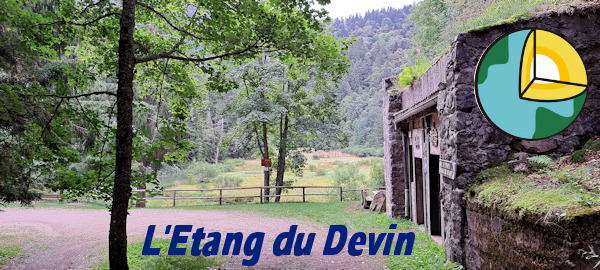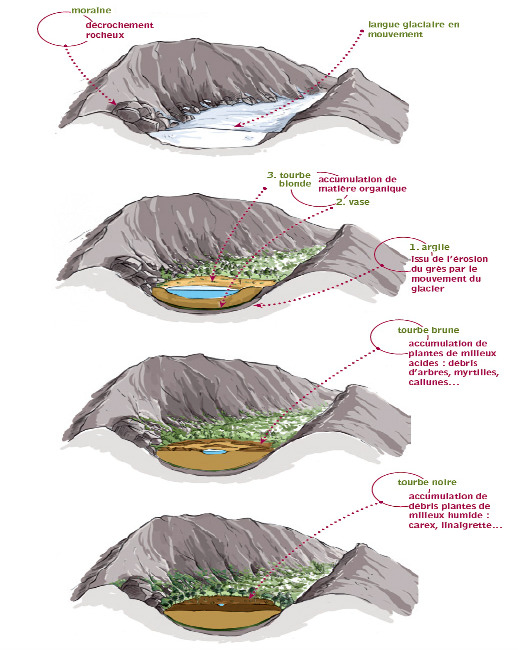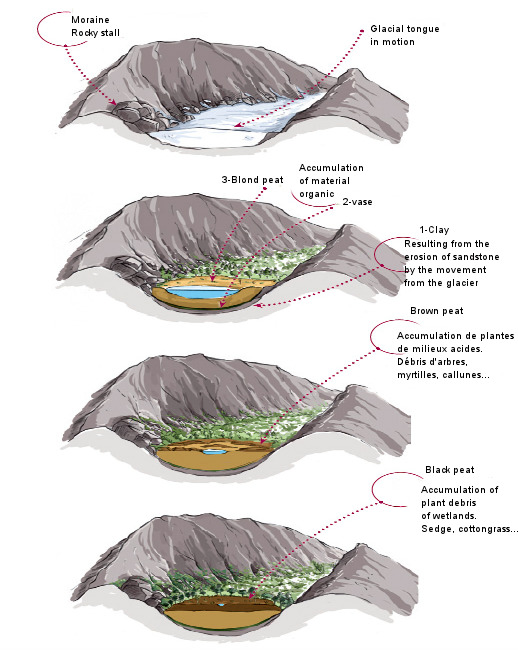 |
...une tourbière !
|
 |

La légende de l'étang du Devin : Colin le Devin.
On ne sait d’où il venait et quand il était arrivé à cet endroit. D’ailleurs, personne ne se posait la question car sa place était ici à l’Etang du Devin, le lieu magique où tout pouvait arriver. C’était lui qui avait aménagé les berges, disposé la prêle à gauche, la linaigrette avec le trèfle d’eau au milieu, la potentille et la canneberge à droite. Au fond, se trouvait sa petite maison avec son unique vache qui paissait tranquillement l’herbe tendre. Les gens de la vallée venaient le voir pour y acheter des plaques de tourbe, combustible de l’époque, qu’il avait mis sécher au bord de l’étang mais aussi pour lui demander des conseils. Il avait toujours les bonnes paroles pour apaiser, pour expliquer, pour raconter et ce qu’il savait le plus c’était écouter.
Un jour, la dame de Gutembourg, le château du village du Bonhomme, passa par là et le vit en train de ramasser des plantes pour les faire sécher. C’était une femme d’une grande prestance comme toutes les châtelaines mais son regard était bien triste. Tout le monde savait qu’elle n’arrivait pas à avoir d’enfants. Colin lui proposa de se reposer sur le banc qu’il avait installé en face de l’étang. Elle s’y assit un bon moment tout en discutant avec son hôte et se sentant en confiance, elle lui fit part de ses difficultés à être enceinte. Alors, il lui demanda de venir avec son mari. Mais elle ne savait comment faire.
– Proposez lui une balade à cheval avec vous ! lui dit-il.
Le lendemain, le châtelain et sa femme arrivèrent près de l’étang. Les voyant sur le banc, Colin leur prépara une boisson rafraichissante car il y faisait très chaud. Puis ils repartirent contents de leur halte. Ce qu’ils ne savaient pas, c’est que leur hôte connaissait très bien les plantes de la fécondité. Neuf mois plus tard, un heureux évènement était accueilli dans toute la vallée.
La châtelaine n’avait pas oublié Colin et pour le remercier lui donna l’étang ainsi qu’un hectare de pré en plus.
C’est ainsi que la légende de Colin le Devin commença et que l’étang porte toujours son nom.
Ref : https://www.etangdevin.com/legendes-etang-devin
Le site
Au quaternaire, il y a 20000 ans, un glacier occupe le massif de la tête des Faux. En rabotant la montagne, il creuse une cuvette aux pentes abruptes.
Quand le climat se réchauffe, il y a environ 11000 ans, le glacier fond et un lac apparaît. Une végétation aquatique s'installe peu à peu.
Au fil du temps, les restes de ces plantes aquatiques se transforment en tourbe et comblent peu à peu l'étang.
La tourbe s'accumule et l'eau disparaît presque entièrement. En 1442, la tourbière de l'étang du Devin est découverte. Au 18ème siècle, des bêtes pâturent sur l'étendue herbeuse.
Au 19ème siècle, le développement industriel entraîne des besoins en combustible de plus en plus importants. Les forêts autour de l'étang sont exploitées, de même que la tourbe.
Les tourbières
Définition
Une tourbière est une zone humide dont le sol est constitué par l'accumulation de tourbe. Super, vous allez me dire. Mais la tourbe, c'est quoi ?
La tourbe est une matière organique fossile formée par accumulation sur de longues périodes de temps de matière organique morte, essentiellement des végétaux, dans un milieu saturé en eau.
La formation du site

Formation de la tourbe
La formation de la tourbe peut être appelée turbigenèse, turfigenèse, turbification ou tourbification. La tourbe est formée dans un sol saturé en permanence d’une eau stagnante ou très peu mobile, privant de l’oxygène nécessaire à leur métabolisme les micro-organismes (bactéries et champignons) responsables de la décomposition et du recyclage de la matière organique. Dans ces conditions asphyxiantes (anaérobiose), la litière végétale ne se minéralise que très lentement et très partiellement. Elle s’accumule alors, progressivement, formant un dépôt de matière organique mal ou non décomposée : la tourbe. En quelque sorte, la tourbe est donc une véritable roche végétale fossile. Elle peut s’accumuler sur plusieurs mètres d’épaisseur, au rythme moyen de 0,2 à 1 mm par an. La plupart des tourbières s’étant formées après le retrait de la dernière glaciation, les dépôts de tourbe généralement observés ont une épaisseur comprise entre 50 cm et 5 à 10 m.
Composition de la tourbe
La tourbe est constituée en grande majorité (80 à 90%) de matières organiques mortes non décomposées. La teneur en carbone peut atteindre 50 % en poids, ce qui fait de la tourbe séchée un relativement bon combustible
Pour valider cette EarthCache
Pour la conservation de ce milieu sensible, merci de rester sur la digue.
Comme toutes les caches de ce type, il n’y a pas de boîte à chercher.
Pour valider votre visite, vous devez répondre aux 4 questions ci-dessous :
Q1 - Il y a 20000 ans, un glacier occupait le site, à quelle époque géologique correspond cette période ?
Q2 - Regarder l'ensemble de l'étang et les pentes montagneuses l'entourant. Que constatez-vous et quel est le nom donné à cette formation géologique ?
Q3 - Observez l'étang et les nappes d'eau : elles sont presque noires. D'après vous, pourquoi sont-elles de cette couleur ?
Q4 - Sur le côté sud de l'étang on peut observer des pierres de formes arrondies arrachées à la montagne par le glacier. Quel nom porte ces décrochements rocheux ?
Non obligatoire. Une photo de vous et/ou de votre GPS sur le site serait la bienvenue.
Loguez cette cache "Found it" et envoyez-moi vos propositions de réponses par la messagerie geocaching.com (Message Center), et en cas de problème je vous contacterai. Ne pas donnez de réponse dans votre log.
Guess what is hidden behind the Etang du Devin...
...a peatland.

Legend of the Devin Pond: Colin le Devin.
We do not know where he came from and when he arrived at this place. Moreover, no one asked the question because his place was here at the Etang du Devin, the magical place where everything could happen. It was he who had arranged the banks, arranged the horsetail to the left, the linaigrette with the water clover in the middle, the potentilla and the cranberry to the right. At the bottom was his little house with his only cow that quietly grazed the soft grass. The people of the valley came to see him to buy sheets of peat, fuel of the time, which he had put dry at the edge of the pond but also to ask him for advice. He always had the right words to soothe, to explain, to tell and what he knew the most was to listen.
One day, the lady of Gutembourg, the castle of the village of Le Bonhomme, passed by and saw him collecting plants to dry them. She was a woman of great presence like all the lords but her look was very sad. Everyone knew she could not have children. Colin offered to rest on the bench he had set up opposite the pond. She sat there for a while while chatting with her host and feeling confident, she told him of her difficulties in being pregnant. So he asked her to come with her husband. But she did not know how.
- Suggest a horse ride with you ! he said.
The next day the squire and his wife arrived near the pond. Seeing them on the bench, Colin prepared them a refreshing drink because it was very hot. Then they left happy with their stop. What they did not know is that their host knew the fertility plants very well. Nine months later, a happy event was hosted throughout the valley.
The squire had not forgotten Colin and to thank him gave him the pond and a hectare of meadow in addition.
This is how the legend of Colin the Seer began and the pond still bears his name.
Ref : https://www.etangdevin.com/legendes-etang-devin
The site
In the Quaternary, 20000 years ago, a glacier occupies the massif of the head of the Faux. By planing the mountain, it digs a basin with steep slopes.
When the climate warms up, about 11000 years ago, the glacier melts and a lake appears. Aquatic vegetation gradually settles in.
Over time, the remains of these aquatic plants turn into peat and gradually fill the pond.
Peat accumulates and the water disappears almost entirely. In 1442, the bog of the Devin pond is discovered. In the 18th century, animals grazed on the grassy expanse.
In the
19th century, industrial development led to increasing fuel requirements. The forests around the pond are exploited, as is peat.
The Peatlands
Definition
A bog is a wetland where the soil is made up of peat accumulation. Great, you’ll tell me. But what is peat?
Peat is a fossil organic material formed by accumulation over long periods of time of dead organic matter, mainly plants, in an environment saturated with water.
The formation of the site

Peat formation
The formation of peat can be called turbigenesis, turfigenesis, turbification or tourbification. Peat is formed in a soil permanently saturated with stagnant water or very little mobile, depriving of the oxygen necessary for their metabolism the microorganisms (bacteria and fungi) responsible for the decomposition and recycling of organic matter. Under these asphyxiating conditions (anaerobic), the plant litter only mineralizes very slowly and very partially. It then accumulates, gradually, forming a deposit of organic matter poorly or not decomposed: peat. In a way, peat is a real fossil plant rock. It can accumulate several metres thick, at an average rate of 0.2 to 1 mm per year. Most peatlands have formed after the last glaciation, and peat deposits generally observed are between 50 cm and 5 to 10 m thick.
Composition of peat
The vast majority of peat (80 to 90%) is made up of decomposed dead organic matter. The carbon content can reach 50% by weight, making dried peat a relatively good fuel.
To validate this EarthCache
For the conservation of this sensitive environment, please stay on the dike.
Like all caches of this type, there is no box to look for.
To validate your visit, you must answer the following 4 questions :
Q1 - 20,000 years ago, a glacier occupied the site, to what geological period does this period correspond ?
Q2 - Look at the whole pond and the mountain slopes surrounding it. What do you see and what is the name given to this geological formation ?
Q3 - Observe the pond and its expanse of water: they are almost black. Why do you think they are that color ?
Q4 - On the south side of the pond you can see rounded stones torn from the mountain by the glacier. What is the name of these rocky outcrops ?
Not required. A photo of you and/or your GPS on the site would be welcome.
Log this cache "Found it" and send me your proposals for answers via geocaching.com (Message Center), and in case of problem I will contact you. Do not answer in your log.